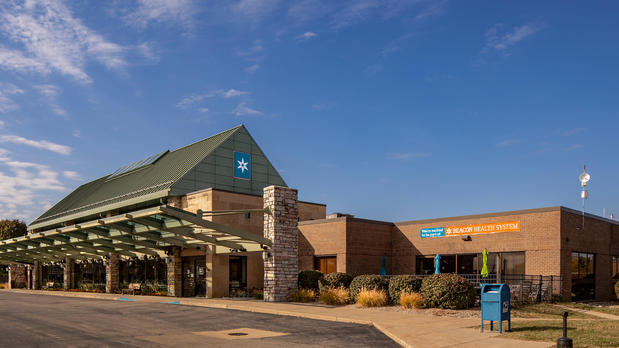Pulmonary atresia with ventricular septal defect
This congenital heart defect affects the valve between the heart and lungs and includes a hole in the heart. Learn the symptoms and how it's treated.
Overview
Pulmonary atresia (uh-TREE-zhuh) with ventricular septal defect, also called PA-VSD, is a heart condition present at birth. That means it's a congenital heart defect.
In pulmonary atresia, the valve between the heart and lungs is not fully formed. This valve is called the pulmonary valve. Blood can't flow from the right lower heart chamber, called the right ventricle, to the lungs. In PA-VSD, there also is a hole between the two pumping chambers of the heart.
Pulmonary atresia with ventricular septal defect is life-threatening. A baby with pulmonary atresia eventually doesn't get enough oxygen. One or more procedures or surgeries are needed to fix the heart.
Symptoms
Symptoms of pulmonary atresia with ventricular septal defect, also called PA-VSD, may appear at birth or very soon after. They can include:
- Blue or gray skin. This change may be harder or easier to see depending on skin color.
- Fast breathing or shortness of breath.
- Tiredness.
- Poor feeding.
When to see a doctor
Pulmonary atresia with ventricular septal defect, also called PA-VSD, is typically found during pregnancy or soon after birth. If your baby has symptoms of this condition after birth, call a healthcare professional right away.
Causes
The cause of pulmonary atresia with ventricular septal defect, also called PA-VSD, is not clear. Most congenital heart conditions happen during the first six weeks of pregnancy. The major blood vessels that run to and from the heart also begin to grow at this time. This is when a congenital heart defect such as pulmonary atresia may occur.
In PA-VSD, the pulmonary valve isn't fully formed. There also is a hole in the heart called a ventricular septal defect. The hole lets blood flow into and out of the right lower heart chamber. Some blood also may flow through a natural opening called the ductus arteriosus. The ductus arteriosus usually closes soon after birth. But medicines can keep it open.
In babies with pulmonary atresia, the lung arteries can be very small. Or they may be missing. If the blood vessels are missing, other vessels form on the body's main artery, called the aorta. These new vessels help send blood to the lungs. They are called major aortopulmonary collateral arteries, also called MAPCAs.
Risk factors
It's not clear what increases the risk of pulmonary atresia with ventricular septal defect. Possible risk factors for congenital heart conditions in general may include:
- Smoking. If you smoke, quit. Smoking during pregnancy or being around cigarette smoke increases the risk of some congenital heart conditions.
- Alcohol use. Drinking alcohol during pregnancy may increase the risk of heart conditions in the baby.
- Some medicines. Some medicines taken during pregnancy may increase the risk of congenital heart conditions. These include lithium (Lithobid) for bipolar disorder and isotretinoin (Claravis, Myorisan, others), which is used to treat acne. Talk with your healthcare team about the medicines you take.
- Genetics. Changes in some genes may affect how a baby's heart forms. For example, people with Down syndrome are often born with heart conditions.
- Diabetes. Having type 1 or type 2 diabetes during pregnancy may change how a baby's heart forms. Diabetes that develops during pregnancy is called gestational diabetes. It typically doesn't increase a baby's risk of congenital heart conditions.
- Rubella, also called German measles. Having rubella during pregnancy can change how a baby's heart forms. A blood test can be done before pregnancy to see if you're immune to rubella. If you're not, a vaccine is available.
Diagnosis
Pulmonary atresia with ventricular septal defect, also called PA-VSD, is often diagnosed during pregnancy or soon after birth.
Tests
Tests that may be used to diagnose pulmonary atresia with ventricular septal defect include:
- Pulse oximetry. For this simple test, a small sensor clips onto a hand or foot. It checks the amount of oxygen in the blood.
- Chest X-ray. A chest X-ray shows the shape and size of the heart and lungs.
- Echocardiogram. This is an ultrasound of the heart. Sound waves make images of the beating heart. An echocardiogram of a baby's heart during pregnancy is called a fetal echocardiogram. It can diagnose pulmonary atresia.
- Electrocardiogram, also called an ECG or EKG. This quick test shows how the heart is beating. Patches with sensors, called electrodes, stick to the chest and sometimes to the arms or legs. Wires connect the patches to a computer, which prints or displays results. An ECG can find irregular heartbeats.
- Cardiac catheterization. A doctor places a flexible tube called a catheter in a blood vessel, usually in the groin or wrist. It's guided to the heart. Dye flows through the catheter to heart arteries. The dye helps the arteries show up more clearly on images.
- Heart CT scan, also called a cardiac CT scan. This test uses several X-rays to make pictures of the heart and blood vessels. It shows the shape of the heart and lungs. A cardiac CT can help diagnose major aortopulmonary collateral arteries, also called MAPCAs. Knowing about the MAPCAs is important for planning treatment.
Treatment
A baby with pulmonary atresia with ventricular septal defect, also called PA-VSD, needs treatment right away. Treatment may include one or more surgeries or procedures.
Surgeries or other procedures
A baby with pulmonary atresia with PA-VSD needs one or more surgeries or procedures to improve blood flow to the lungs. The treatments also help the heart work better. Treatment depends on the structure of the pulmonary arteries and whether there are major aortopulmonary collateral arteries, also called MAPCAs.
Surgeries or other procedures may include:
- Catheter procedure. Thin, flexible tubes called catheters are used to look at the baby's heart and blood supply to the lungs. Sometimes a rigid tube called a stent is placed in the patent ductus arteriosus. This keeps the vessel open and lets blood flow into the lungs.
- Systemic-to-pulmonary artery shunt. This surgery may be needed in the first few days of life to send more blood to the lungs. The surgeon makes a connection, called a shunt, using a small tube. An example is the Blalock-Taussig shunt, also called the BT shunt.
- Complete repair. This treatment may be done when as a baby is young or after a shunt or stent is placed. During complete repair, a surgeon closes the hole in the heart. The surgeon creates a pathway between the right lower heart chamber and the pulmonary artery.
- Unifocalization. Sometimes, when most of the blood going to the lungs is through MAPCAs, those blood vessels need to be connected. This surgery is called unifocalization. The surgery may be done in stages. It may be done as part of a complete repair. Sometimes it's the first step toward an eventual complete repair.
Babies with pulmonary atresia with ventricular septal defect need regular checkups by a doctor trained in heart conditions present at birth. This type of doctor is called a congenital cardiologist.
© 1998-2025 Mayo Foundation for Medical Education and Research (MFMER). All rights reserved.
Terms of Use





